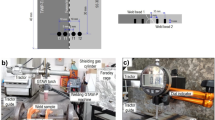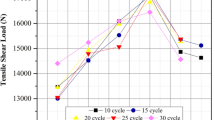Abstract
In dissimilar welded joints without filler materials, the dilution is one of the most important factor for the weldability. Due to other factors, the high quality of the welding seam and a good reproducibility of welding parameters the electron beam can be advantageously used to join challenging materials. Several dissimilar welded joints were successfully produced as a result of an optimised variation of the beam offset and the beam current to achieve suitable levels of dilution. For microstructural evaluation, the welded joints were examined by light optical and scanning electron microscopy methods, such as Electron Backscatter Diffraction (EBSD) and Wavelength-dispersive X-ray spectroscopy (WDS). To characterise the mechanical properties and the deformation behaviour of the welded material, microhardness measurements and tensile tests were carried out. For the welds of a high-alloy TRIP steel and the steel DP590, an optimised dilution lead to flawless joints with a tensile strength superior to the TRIP steel. Furthermore, welds of a zirconia-reinforced TWIP steel with an as-cast TRIP steel free of pores and cracks could be produced.












Similar content being viewed by others
References
Martin S, Wolf S, Martin U, Krüger L, Rafaja D (2016) Deformation mechanisms in austenitic TRIP/TWIP steel as a function of temperature. Metallurgical and Materials Transactions A 47(1):49–58. doi:10.1007/s11661-014-2684-4
Weiß A, Gutte H, Jahn A, Scheller PR (2009) Nichtrostende Stähle mit TRIP/TWIP/SBIP-Effekt. Mater Werkst 40(8):606–611
Buchwalder A, Rüthrich K, Zenker R, Biermann H (2013) Electron beam welding of high alloy CrMnNi cast steels with TRIP/TWIP effect. Adv Eng Mater 15(7):566–570
Ehinger D, Krüger L, Martin U, Weigelt C, Aneziris CG (2013) Temperature effects on the deformation behavior of high-density TRIP steel and particle-reinforced TRIP steel/zirconia honeycombs under quasi-static compressive loading. Adv Eng Mater 15(7):646–657
Nouri M, Abdollah-zadeh A, Malek F (2007) Effect of welding parameters on dilution and weld bead geometry in cladding. J Mater Sci Technol 23(6):817–822
Fritzsch K, Buchwalder A, Zenker R, Jung A (2014) Influence of electron beam liquid phase surface treatments on the corrosion resistance of AZ91D using different additive deposition techniques. Corros Sci 88:109–117
Jung A, Sohr T, Zenker R, Lerche J, Lerche K (2015) Elektronenstrahl-Auftragen von Verschleißschutzschichten auf korrosionsbeständige Stähle*. HTM 70(3):135–141
Mangler M, Rüthrich K, Zenker R (2009) Untersuchungen zum Elektronenstrahl-Mehrbadschweißen vonGusseisen-Stahl-Mischverbindungen. In: Wissenschaftliche Zeitschrift der Hochschule Mittweida 5 S. 89–92; 20th International Scientific Conference Mittweida, Okt. 28–29, 2009
Halbauer L, Zenker R, Weidner A, Buchwalder A, Biermann H (2015) Influence of EB parameters on the microstructure and mechanical properties of dissimilar welded joints in high alloy TRIP/TWIP steels. In: Ponomarov V (ed) JOM18 Conference Proceedings, S. 1–7, 18th International Conference on the Joining of Materials. Institute for the joining of materials, Helsingør, Denmark, 26–29 June 2015
Pasquale RS, de Maddis M, Lombardi F, D’Aiuto F (2013) Resistance spot welding of advanced high strength TWIP steels. Applied Mechanics and Materials 423-426:876–880
Zhang B, Wang T, Duan X, Chen G, Feng J (2012) Temperature and stress fields in electron beam welded Ti-15-3 alloy to 304 stainless steel joint with copper interlayer sheet. Trans Nonferrous Metals Soc China 22(2):398–403
Saha DC, Han S, Chin KG, Choi I, Park Y (2012) Weldability evaluation and microstructure analysis of resistance-spot-welded high-Mn steel in automotive application. Steel Res Int 83(4):352–357
Mujica L, Weber S, Pinto H, Thomy C, Vollertsen F (2010) Microstructure and mechanical properties of laser-welded joints of TWIP and TRIP steels. Mater Sci Eng A 527(7-8):2071–2078
Behm V, Höfemann M, Hatscher A, Springer A, Kaierle S, Hein D et al (2014) Investigations on laser beam welding dissimilar material combinations of austenitic high manganese (FeMn) and ferrite steels. Phys Procedia 56:610–619
Rossini M, Spena PR, Cortese L, Matteis P, Firrao D (2015) Investigation on dissimilar laser welding of advanced high strength steel sheets for the automotive industry. Mater Sci Eng A 628:288–296
Pasquale RS, Matteis P, Scavino G (2014) Dissimilar metal active gas welding of TWIP and DP steel sheets. Steel Res Int 5:495–501
Acknowledgments
The authors gratefully acknowledge the German Research Foundation (DFG) for supporting this work, which was carried out within the framework of the Collaborative Research Centre (SFB) 799, subproject A7. Furthermore, they would like to thank the German Welding Society for supporting the participation in the 67th Annual Assembly and International Conference and Mr. M. Flume from voestalpine Stahl GmbH for providing the tested DP590. The authors would also like to thank K. Fischer for the SEM investigations, Dr. K. Pranke for the hot-rolling experiments on the PM material, and G. Schade for the realisation of the tensile tests.
Author information
Authors and Affiliations
Corresponding author
Additional information
Recommended for publication by Commission IV - Power Beam Processes
Rights and permissions
About this article
Cite this article
Halbauer, L., Buchwalder, A., Zenker, R. et al. The influence of dilution on dissimilar weld joints with high-alloy TRIP/TWIP steels. Weld World 60, 645–652 (2016). https://doi.org/10.1007/s40194-016-0324-x
Received:
Accepted:
Published:
Issue Date:
DOI: https://doi.org/10.1007/s40194-016-0324-x




